Danfoss will highlight its latest innovations and broad portfolio of solutions for the HVAC/R industry at the annual AHR Expo, February 10-12 in Orlando, Fla. At booth #1301, visitors can discover how Danfoss can help their customers reach decarbonization goals under the theme, “Transition Forward.” With an expected 50,000 attendees and 1,800 exhibitors, the premier Read more
Danfoss
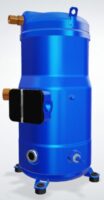
Danfoss will highlight its latest innovations and broad portfolio of solutions for the HVAC/R industry at the annual AHR Expo, February 10-12 in Orlando, Fla. At booth #1301, visitors can discover how Danfoss can help their customers reach decarbonization goals under the theme, “Transition Forward.” With an expected 50,000 attendees and 1,800 exhibitors, the premier annual event for the HVAC/R industry provides an invaluable opportunity to showcase the company’s technologies that enable customers to build heat pumps, data centers, rooftop units, Dedicated Outdoor Air Systems (DOAS), chillers and refrigeration systems that reduce carbon emissions and energy consumption.
Reflecting the growing push toward decarbonization and Danfoss’ ESG goal of becoming their customers’ preferred partner to help meet their decarbonization goals, Danfoss HVAC/R solutions offer sustainable solutions to end users looking to reduce their carbon footprint along with their energy and maintenance expenses.
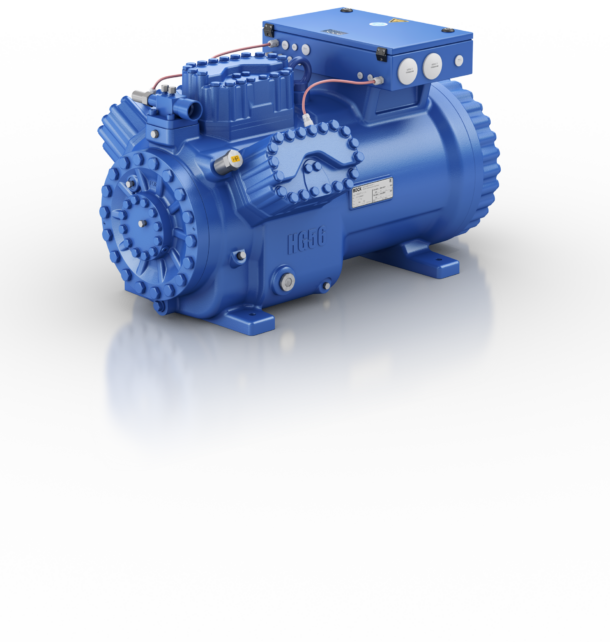
The BOCK HGX56 CO2 T compressor, VZH-VI variable speed scroll compressor with injection, and EKE110 controller will be on display at the Danfoss booth, #1301, at AHR Expo.
On display will be the newest technologies, including:
- VZH VI variable speed compressor range with injection
- The latest Turbocor® oil-free and magnetic bearing compressors
- Danfoss’ CO2 solutions for food retail
- X-Gate gateway solution for integrating multiple devices into building management systems
- The Danfoss Advanced Active Filter AAF 007, now expanded to 100/150A module, for higher efficiency in harmonics
- MyDrive® Harmonics software solution for mitigating harmonic distortions in HVAC systems
- EHW194 hose for data center cooling systems
Also on display will be the new BOCK HGX56 CO2 T compressor, winner of the Expo’s Innovation Award in the Refrigeration category. The latest Danfoss innovation for sustainable refrigeration, the HGX56 CO2 T is a transcritical semi-hermetic CO2 (R744) compressor, ideal for industrial refrigeration, cold storage, ice sports facilities and heat pumps, including process and district heating applications. The expansion to 6-cylinder capacity allows for a wider spread and faster uptake of large CO2 heat pumps and industrial refrigeration systems, along with lower system complexity and investment costs. As an award category winner, the HGX56 CO2 T compressor is a finalist for Product of the Year, which will be announced at the Expo.
Visitors to the Danfoss booth will also be able to see demonstrations of Alsense and Alsmart HVAC/R automation solutions, the VLT® HVAC FC 102 Drive NEMA 4X, condition-based monitoring (CBM), TurbocorCloud® software, and more.
AHR Expo will mark the start of the celebration of the 30th anniversary of Danfoss Turbocor. Founded in 1995 in Australia by a group of engineers and later acquired by Danfoss as a wholly owned company, the pioneer in oil-free compressor technology has grown to 350 employees with operation centers in the U.S., Denmark and China. Over 140,000 Turbocor compressors have been installed globally as more customers seek to lower their carbon emissions and energy consumption.
“Danfoss is set to showcase its cutting-edge innovations in decarbonization and energy efficiency at the AHR Expo,” said Vikas Anand, vice president of sales for North America at Danfoss Climate Solutions. “Our primary focus is to support our customers on their decarbonization journey and transition to low-GWP refrigerants. Expo attendees will have the opportunity to explore our extensive range of HVAC/R solutions that are driving the industry toward a more sustainable & energy efficient future.”
“At Danfoss, we are committed to providing reliable and innovative solutions that address current challenges and future opportunities,” said Hannes Leichtfried, vice president of sales and marketing for North America at Danfoss Drives. “Our U.S.-based production ensures localized support and high-quality products that maximize energy efficiency and decarbonization. This local presence, combined with our global expertise, helps our customers achieve their sustainability goals while navigating market complexities.”

Danfoss, a global leader in climate and energy solutions, has joined forces with Enersponse, a leading distributed energy resource (DER) management company based in California, to introduce cutting-edge services for American supermarkets. This collaboration aims to enhance energy flexibility in HVAC and refrigeration systems by unlocking benefits for the food retail sector with the Automated Read more
Danfoss, a global leader in climate and energy solutions, has joined forces with Enersponse, a leading distributed energy resource (DER) management company based in California, to introduce cutting-edge services for American supermarkets.
This collaboration aims to enhance energy flexibility in HVAC and refrigeration systems by unlocking benefits for the food retail sector with the Automated Demand Response (Auto-DR) solution.
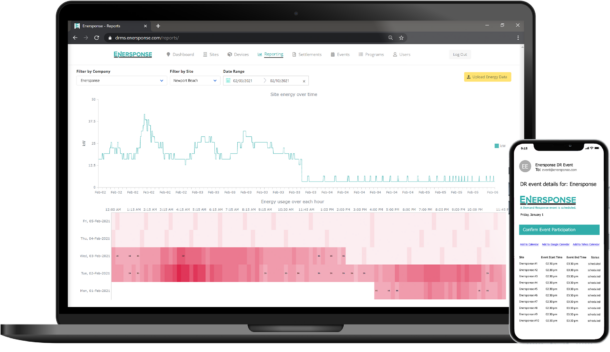
Providing Demand Flexibility and Energy Efficiency
The food retail industry is transforming through digitalization and sustainability is a key phase of this journey. To foster the green transition, Danfoss and Enersponse will collaborate to ensure food retailers achieve grid stability, while reaping financial rewards automatically, via Auto-DR. By reducing energy usage when electricity demand exceeds supply, Auto-DR helps ensure the lights stay on and the food stays fresh, all while reducing energy use during peak periods which often correlates with high emission periods.
Enersponse’s DERMS Platform will be seamlessly integrated into Danfoss Alsense®, an Internet of Things (IoT) food retail services cloud solution that tracks refrigeration asset performance, allowing retail managers to easily respond to alarms, ensure 24/7 monitoring of food conditions, and reduce energy consumption.
“We maintain an unwavering commitment to seeking out premier building control partners, enhancing the impact of our energy initiatives,” explained James McPhail, the visionary CEO and founder of Enersponse. “Being at the forefront of our industry with unmatched technology, collaborating with a company like Danfoss was an obvious choice. This partnership marks a significant milestone for both organizations, delivering not only excitement but also substantial benefits to their customers such as tailored demand response events, the generation of a passive income all while maintaining adherence to safety standards to ensure perishable foods remain well within the designated safe temperature zones and a multitude of other advantages.”
“We are thrilled to partner with Enersponse to expand our offerings to food retail customers in the United States,” says Natalie Schnippering, Danfoss Head of Digital Services. “With digital innovation, we can capture supermarket data and gain the insight needed to optimize energy use, automate corrective actions, and prevent peak loads and energy waste.”
Tangible Impact of Automatic Demand Response Measures
Electricity consumption varies throughout the day and year. Uncontrolled demand-side consumption will, therefore, often lead to critical congestion in the grid during peak hours. Demand-side flexibility and energy efficiency measures shift the energy consumption to times when demand is lower. This proactive Smart Demand Response approach from Danfoss and Enersponse enables supermarkets to reduce electricity costs by lowering cooling loads during peak hours.
According to the International Energy Agency, Smart Demand Response could provide 185 gigawatts (GW) of system flexibility, equivalent to the currently installed electricity supply capacity of Australia and Italy combined.

Danfoss, a leading global supplier of technologies for HVAC/R, will exhibit their broad portfolio of solutions to help their customers reach decarbonization goals at the annual AHR Expo, January 21-23, the premier annual event for the HVAC/R industry. With an expected 50,000 attendees and 1,600 exhibitors, the event provides an invaluable opportunity to showcase the company’s technologies Read more
Danfoss, a leading global supplier of technologies for HVAC/R, will exhibit their broad portfolio of solutions to help their customers reach decarbonization goals at the annual AHR Expo, January 21-23, the premier annual event for the HVAC/R industry. With an expected 50,000 attendees and 1,600 exhibitors, the event provides an invaluable opportunity to showcase the company’s technologies that enable customers to build energy-efficient heat pumps, data centers, rooftop units, Dedicated Outdoor Air Systems (DOAS), chillers and food retail refrigeration systems. Reflecting the growing push toward decarbonization, Danfoss HVAC/R solutions offer robust and energy-efficient performance to end users looking to reduce carbon emissions along with their energy and maintenance expenses.
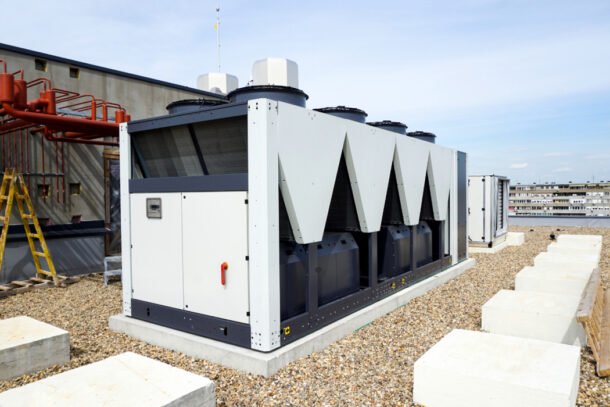 On display will be the newest technologies, including the BOCK 6-cylinder CO2 compressor, its accompanying CO2 condensing unit, Turbocor compressors, the iC2 Micro family of drives and the EC+ technology for HVAC drives. Booth visitors will be able to see demonstrations of Alsmart and Alsense, Danfoss’ automation solutions for building HVAC systems and food retail, respectively. A feature this year will be a Lego-sized model of a Smart Store, utilizing the latest energy-efficient and low-carbon food retail solutions. Visitors to the booth will have the opportunity to enter to win a set of Legos by snapping a selfie next to the Smart Store display, posting the photo on LinkedIn and tagging the Danfoss North America page.
On display will be the newest technologies, including the BOCK 6-cylinder CO2 compressor, its accompanying CO2 condensing unit, Turbocor compressors, the iC2 Micro family of drives and the EC+ technology for HVAC drives. Booth visitors will be able to see demonstrations of Alsmart and Alsense, Danfoss’ automation solutions for building HVAC systems and food retail, respectively. A feature this year will be a Lego-sized model of a Smart Store, utilizing the latest energy-efficient and low-carbon food retail solutions. Visitors to the booth will have the opportunity to enter to win a set of Legos by snapping a selfie next to the Smart Store display, posting the photo on LinkedIn and tagging the Danfoss North America page.
Also on display will be the new DSG compressor, winner of the Expo’s Innovation Award in the Cooling category. The DSG is specifically designed for low pressure, low GWP (global warming potential) refrigerants and provides chiller systems with a wide range of compressor capacities to support unit design requirements. It showcases Danfoss expertise in helping its customers make the transition to environmentally friendly refrigerants as HFC phasedown continues. As an award category winner, the DSG compressor is a finalist for Product of the Year, which will be announced at the Expo.
“Danfoss innovation in decarbonization and energy efficiency will be on full display at the Expo,” said Rick Sporrer, president of Danfoss North America. “With our broad portfolio of solutions, we have the expertise needed to become our customers’ preferred decarbonization partner. We are looking forward to highlighting our latest solutions and sharing our insights with the industry.”
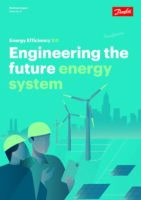
New study by Danfoss shows roll-out of demand-side flexibility technology can achieve annual societal cost savings of $10.5 billion by 2030, and 7% savings on electricity bills for households A new analysis commissioned by Danfoss reveals that an ambitious but realistic roll out of demand-side flexibility technology in the EU and UK can save 40 million Read more
New study by Danfoss shows roll-out of demand-side flexibility technology can achieve annual societal cost savings of $10.5 billion by 2030, and 7% savings on electricity bills for households
A new analysis commissioned by Danfoss reveals that an ambitious but realistic roll out of demand-side flexibility technology in the EU and UK can save 40 million tons of CO2 emissions each year by 2030, more than Denmark’s domestic climate footprint. In the U.S., demand-side flexibility, combined with optimized efficiency and the adoption of electric power sources, could save over $100 billion in energy costs and lower carbon emissions from buildings by over 90 percent by 2050.
Rolling out demand-side flexibility technologies can make the grid more resilient and create substantial economic benefits for societies and households. Managing our energy more effectively and lowering demand in peak periods can reduce the risk of potential outages by lowering the strain on the grid. Consumers will see savings on their utility bills, as the cost of electricity is lower during non-peak periods.
Kim Fausing, President and CEO, Danfoss says: “We are leaving the fossil fuel era, but we haven’t prepared our energy system for the future because we are neglecting energy efficiency as one of the main tools to lower emissions. The grid is not ready to use all the renewable energy we are making rapid progress to produce. We must take steps to utilize energy efficiency solutions – such as demand-side flexibility technologies – that not only help us to use less energy, but to use the right energy at the right time. We have the solutions, but we need action.”
Demand-side flexibility refers to the levelling out of energy consumption to prevent periods of simultaneous high demand and low supply, which is especially important for an energy system based on renewables. The deployment of demand-side flexibility technologies can lower demand during expensive peak hours and reduce the amount of fossil fuels in the energy mix.
In buildings, for example, AI-driven technologies can save up to 20 percent in a building’s energy costs by combining building, weather, and user data to predict heating and ventilation demand.[i] Observations on 100,000 flats equipped with this technology, based mainly in Finland, show that the maximum power usage was reduced by 10-30 percent.[ii] Meanwhile, load-shifting can also be automated to cool supermarket freezers down to a much lower temperature than required outside the peak demand hours with the freezers effectively operating like a battery storing energy. This ‘supercooling’ technique means refrigerators can be switched off during the peak hours of energy demand, both lowering stress on the grid and saving money for the supermarket.
Renewables need to make up 70 percent of the energy mix by 2050 if the goals of the Paris Agreement are to be reached. However, the energy system is not yet prepared to manage the natural peaks and troughs of renewable energy supply.The new whitepaper from Danfoss, “Energy Efficiency 2.0: Engineering the Future Energy System”, presents the most cost-efficient way to prepare for the future energy system. It focuses on the deployment of a full-scale electrification of society, demand-side flexibility measures, wise use of hydrogen and storage and maximizing the use of excess heat.
Key whitepaper takeaways:
- By transitioning from a fossil energy system to a fully electrified one, it is possible to cut up to 40% of final energy consumption. Electrification is itself a form of energy efficiency.
- Through demand-side flexibility, the EU and UK can annually save 40 million tons of CO2 emissions and achieve annual societal cost savings of €10.5 billion by 2030. Similarly, households can save on average 7% on their electricity bills. In 2050, households are estimated to save 10% on electricity bills and €15.5 billion annual societal costs.
- In the US, optimizing efficiency, demand flexibility, and electrification in buildings can save up to $107 billion in annual power system cost savings alongside a 91% reduction in carbon emissions from buildings by 2050.
- In 2030, up to 53% of the global energy input will be wasted as excess heat. However, much of this heat can be captured and reused to heat buildings and water through deeper sector integration.
- On a global scale it is theoretically possible by 2050 to recover 1.228 TWh of excess heat from hydrogen produced through electrolysis – this is equivalent to almost two thirds of today’s global heat generation from coal, the largest source of heat.
Kim Fausing adds: “Electrification, demand-side flexibility, conversion, storage, and sector integration must take center stage in a future energy system enabling an energy grid powered by renewables. Seeing is believing, and, often, decision makers simply don’t know that we already have the solutions we need to not only reduce carbon emissions, but also to deliver substantial economic savings both at a societal and customer level. It’s about time for decision makers at all levels to prioritize energy efficiency and set the right regulatory and economic framework to reach net zero by 2050.”
Professor Nick Eyre, Professor of Energy and Climate Policy at University of Oxford & Senior Research Fellow in Energy at the Environmental Change Institute, says: “We need to rethink energy efficiency and place it at the center of the race towards full decarbonization. This means enabling the electrification of end-uses not previously served by electricity. It also means creating a highly flexible energy system to avoid carbon-intensive demand peaks. Historically, energy efficiency has delivered the largest share of greenhouse gas mitigation and reinventing it for the era of renewables will enable us to continue this trend and achieve net zero by 2050.”
Toby Morgan, Senior Manager, Built Environment at Climate Group, says: “As we electrify everything we can and build a flexible grid fit for the future, we cannot forget energy efficiency. The greenest form of energy is saving energy, and efficiency means we need fewer wind farms and fewer battery facilities. AI can help turbocharge progress on energy efficiency, optimizing electricity usage for any given time of day. Yet AI’s role in connecting up climate-smart technologies in one integrated, energy efficient building is where it gets really exciting. AI can optimize the use of rooftop solar when it’s sunny, make decisions on when to draw on the building’s battery storage, or the batteries of EVs plugged into its charging points when it’s not, plus choose an optimum time to sell renewable electricity back to the grid when demand is high.”
Download the full whitepaper: “Energy Efficiency 2.0: Engineering the Future Energy System”
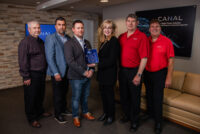
Winners represent wide range of engineering innovation Danfoss has announced the winners of its 2023 EnVisioneer of the Year competition. ThermalWorks, Polar Engineering, Canal Marine and Industrial Inc. and Weis Markets took top honors in the new, expanded format that allows for multiple winners. ThermalWorks, based in Bloomingburg, New York, was the winner in the Read more
Winners represent wide range of engineering innovation
Danfoss has announced the winners of its 2023 EnVisioneer of the Year competition. ThermalWorks, Polar Engineering, Canal Marine and Industrial Inc. and Weis Markets took top honors in the new, expanded format that allows for multiple winners.
ThermalWorks, based in Bloomingburg, New York, was the winner in the Original Equipment Manufacturer (OEM) category for its advanced waterless cooling system. The company built a modular, hyper-efficient, waterless chiller for the data center industry using state-of-the-art Danfoss products, including its oil-free Turbocor compressors. The fully-integrated, scalable system features a unique chilled water circuit design that rejects heat in stages – free cooling, partial free cooling, high temperature mechanical and low temperature mechanical – with one integrated unit. In addition to using no water, energy use is greatly reduced, resulting in lower carbon emissions and low Power Usage Effectiveness (PUE) values compared to other high-efficiency systems.

The ThermalWorks team was presented with their EnVisioneer of the Year award by Danfoss Turbocor president Ricardo Schneider at Danfoss Turbocor headquarters in Tallahassee, Florida.
Polar Engineering, based in Victoria, British Columbia, was the Engineering Consultant category winner. Its low-GWP, high-temperature heat pump, built by Fraser Valley Refrigeration using Danfoss solenoid, isolation, and electronic expansion valves, including the Colibri EEV, has helped reduce natural gas usage at the Juan de Fuca Recreation Center by 90 percent. As part of an energy recovery system, the heat pump recaptures waste heat from the ammonia refrigeration system on site and uses it to offset the boiler loop load of the facility, resulting in an annual savings 284 tons of carbon emissions and $22,000 in fuel costs.
Pennsylvania-based Weis Markets, the End User category winner, installed a CO2 refrigeration system at its new store in Warminster, Penn. The Danfoss AK-SM 880A controller, with its communications modules, sensors, cables and valves, provides the brains behind the system, monitoring for leaks and ensuring that temperatures remain stable at desired levels. In the first four months of operation, refrigeration energy consumption was over 100,000 kWh less than at a comparable store with traditional refrigeration, saving an estimated $11,000. And by using CO2, with a GWP of 1, as the refrigerant, the store’s impact on air pollution is estimated to be 1500-4000 times less per pound of refrigerant compared to HFC/HFO refrigerants.

The Weis Markets team was presented with their award by Vikas Anand, vice president of sales at Danfoss Climate Solutions, North America, at their Warminster, Penn. store.
Canal Marine and Industrial won in the System Integrator category. The St. Catharines, Ontario-based company built an electric power system for PortsToronto’s Marilyn Bell I, Canada’s first 100 percent electric lithium-ion powered ferry. Annually, this transition to renewable power is saving 530 tons of carbon emissions, reducing estimated energy and operating costs by $150,000 on a yearly basis as well as eliminating the use of approximately 196,000 liters of diesel per year. The vessel’s propulsion system utilizes Danfoss’ air-cooled VACON® NX Series drive modules, grid converters and DC/DC converters plus filters. The components work together in common DC bus topologies to provide power conversion between the batteries and motors to power the vessel’s thrusters and other electrical systems. The batteries are charged through the common DC bus distribution system via an Automatic Shore Connection System which delivers and controls DC power via a VACON® Active Front End from the grid.
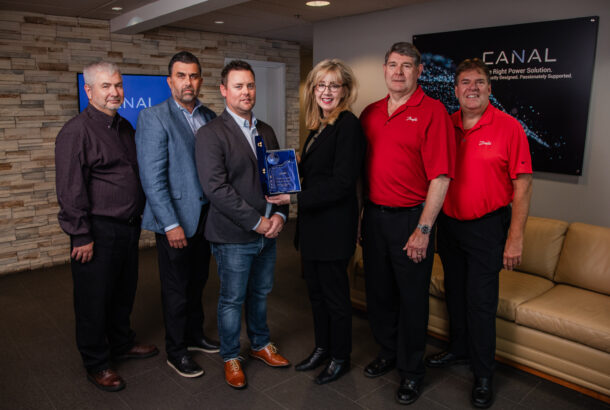
Sheila Lenss, former head of sales, Americas at Danfoss Drives, presented the Canal Marine and Industrial team with their EnVisioneer of the Year award at Canal’s corporate headquarters in St. Catharines, Ontario.
Launched in 2010, the annual EnVisioneer of the Year award competition recognizes North American original equipment manufacturers, building owners, municipalities, contractors and end users that have introduced a new product, opened a new facility or invested in a building or system upgrade in the past 18 months using Danfoss products or solutions to realize significant energy and environmental savings. Entries are judged by an independent panel of distinguished experts representing various disciplines.
“We are thrilled to recognize our EnVisioneers of the Year for their innovative work,” said Rick Sporrer, president of Danfoss North America. “Each of our winners has used Danfoss solutions to build a cleaner, more sustainable future. We applaud them for their ingenuity and their commitment to lowering carbon emissions and increasing energy efficiency.”
